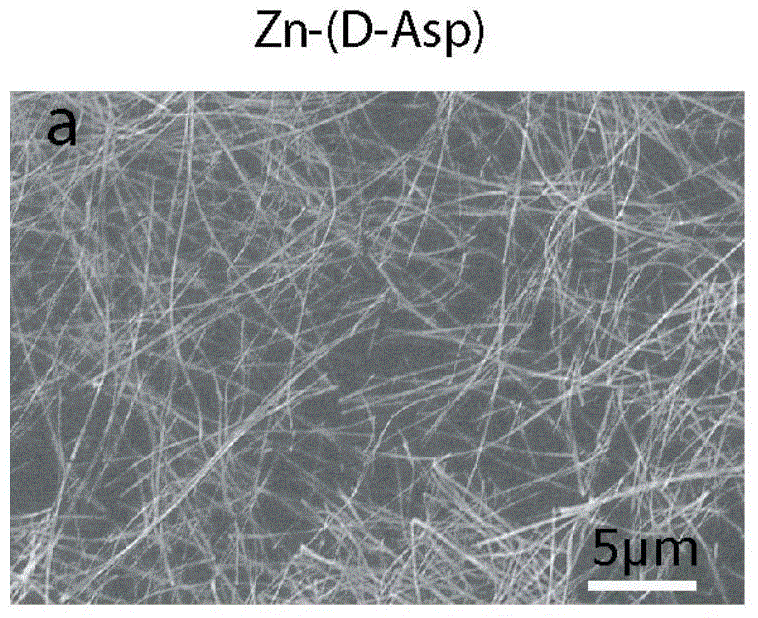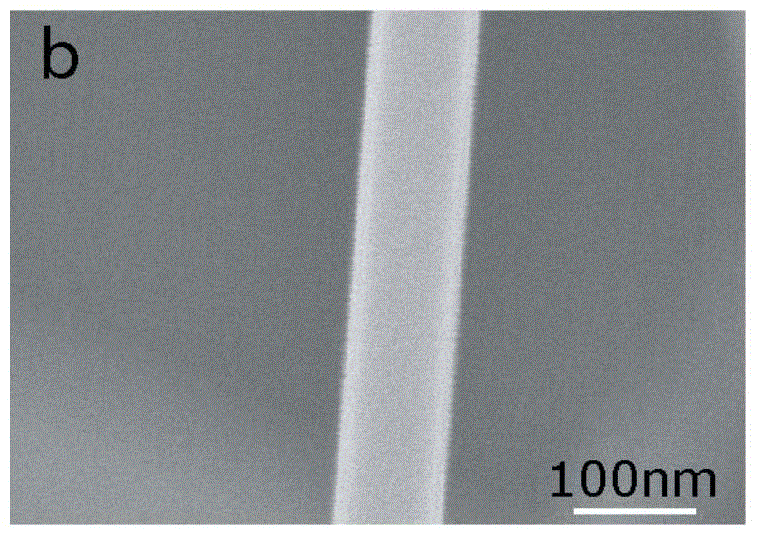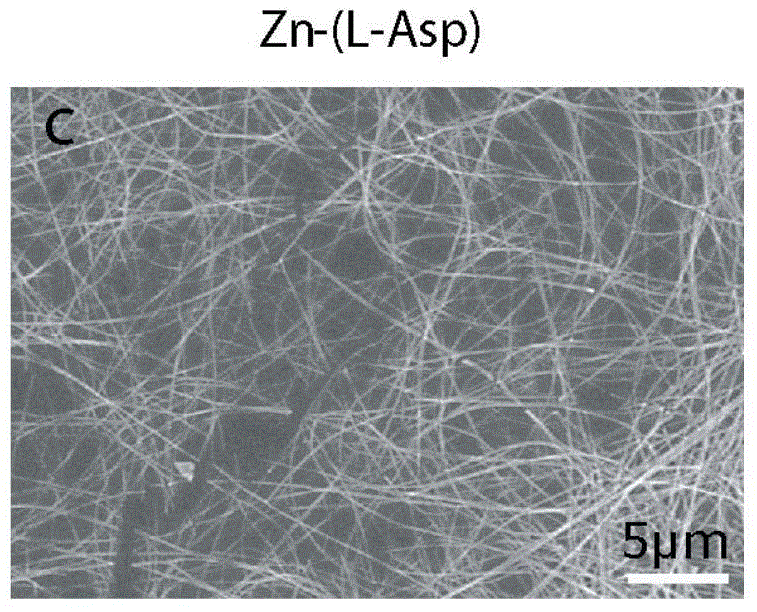Chiral nanometer fiber and its preparation method and use
A nanofiber and chiral technology, applied in the field of biomedicine, can solve the problems of lack of anti-tumor activity, strong hepatotoxicity, poor tumor suppression effect, etc., achieve inhibition of invasion and migration activity, good invasion and migration activity, and avoid toxic side effects Effect
- Summary
- Abstract
- Description
- Claims
- Application Information
AI Technical Summary
Problems solved by technology
Method used
Image
Examples
Embodiment 1
[0037] Embodiment 1: Preparation of Zn-Asp chiral nanofibers
[0038] (1) Preparation of amino acid solution: Weigh 133 mg of aspartic acid and dissolve it in 6 mL of absolute ethanol, add 1 mL of 2 mmol of sodium hydroxide aqueous solution to prepare 1 mmol of aspartic acid solution;
[0039] (2) Preparation of zinc nitrate solution: take 595 mg of zinc nitrate hexahydrate and dissolve it in 2 mL of ultrapure water to prepare 2 mmol of zinc nitrate solution;
[0040] (3) Titrate the aspartic acid solution with the zinc nitrate solution under stirring conditions, react the mixture on the water-absolute ethanol interface for 14 days, then wash with 10mL of anhydrous methanol three to five times, and put it in a vacuum drying oven Set aside to dry.
[0041] It can be seen from Figure 1 that Zn-Asp chiral nanofibers are fibrous, with a diameter of about 150nm and a length of 200-500μm.
Embodiment 2
[0042] Example 2: Interaction of Zn-Asp chiral nanofibers and tumor-associated proteins
[0043] 1. Interaction of Zn-Asp chiral nanofibers with HSP90
[0044] 200 μg Zn-Asp chiral nanofibers were incubated with 1 mL of purified recombinant protein HSP90 containing 2, 4, 8, 16, 24, 32, 48 and 72 μg at 37°C for 1 hour, centrifuged to discard the supernatant, and washed with PBS buffer After 3 times, the final pellet was resuspended with 2× loading buffer, then run for SDS-PAGE electrophoresis and stained with Coomassie brilliant blue.
[0045] 2. Zn-Asp chiral nanofibers interact with tumor cells
[0046] (1) The tumor cells were inoculated in serum-free DMEM medium, and after culturing for 48 hours, the supernatant was taken and labeled as sample SF;
[0047] (2) Inoculate tumor cells in serum-free DMEM medium, culture for 24 hours, add 200 μg / mL Zn-Asp chiral nanofibers to the medium and culture for another 24 hours, take the supernatant and mark it as sample SF+D (S) and ...
Embodiment 3
[0051] Example 3: Inhibition of Zn-Asp Chiral Nanofibers on Tumor Cell Proliferation, Migration and Invasion
[0052] Add 200 μg / mL Zn-Asp chiral nanofibers to 1% FBS cell culture medium and 10% FBS cell culture medium respectively, incubate the cells for 24 hours, and set up a parallel control group without chiral nanofibers in the cell culture medium , and then detect changes in cell viability, migration, and invasion.
[0053] As can be seen from Figure 3, (a) and (b) show that D- / L-Zn-Asp chiral nanofibers can bind HSP90, and show a significant concentration-dependent effect; (c) D- / L-Zn -Asp chiral nanofibers were also able to bind different gelatinases: MMP-9 polymers, MMP-9 precursors, MMP-2 precursors and active forms of MMP-2.
[0054] As can be seen from Figure 4, (a) shows that 200 μg / mL of D- / L-Zn-Asp chiral nanofibers cause 54% inhibition of cell migration; (b) shows that 200 μg / mL of D- / L-Zn- Asp chiral nanofibers caused 78% and 74% inhibition of cell invasion,...
PUM
| Property | Measurement | Unit |
|---|---|---|
| Diameter | aaaaa | aaaaa |
| Length | aaaaa | aaaaa |
| Diameter | aaaaa | aaaaa |
Abstract
Description
Claims
Application Information
 Login to View More
Login to View More - R&D
- Intellectual Property
- Life Sciences
- Materials
- Tech Scout
- Unparalleled Data Quality
- Higher Quality Content
- 60% Fewer Hallucinations
Browse by: Latest US Patents, China's latest patents, Technical Efficacy Thesaurus, Application Domain, Technology Topic, Popular Technical Reports.
© 2025 PatSnap. All rights reserved.Legal|Privacy policy|Modern Slavery Act Transparency Statement|Sitemap|About US| Contact US: help@patsnap.com



